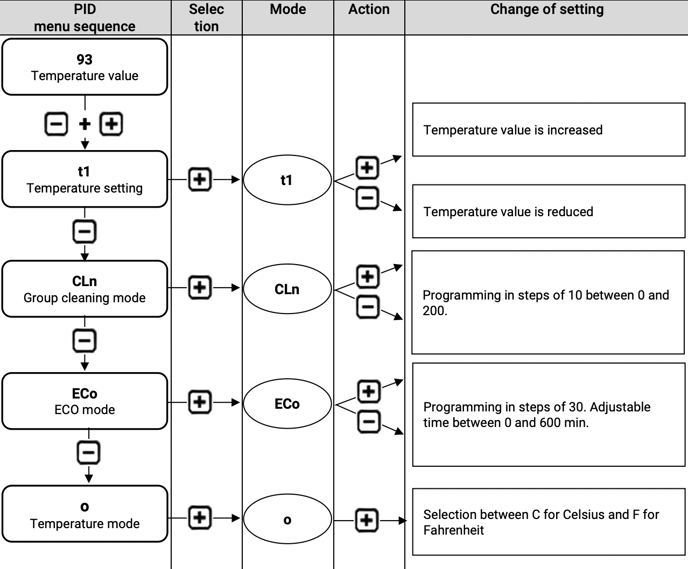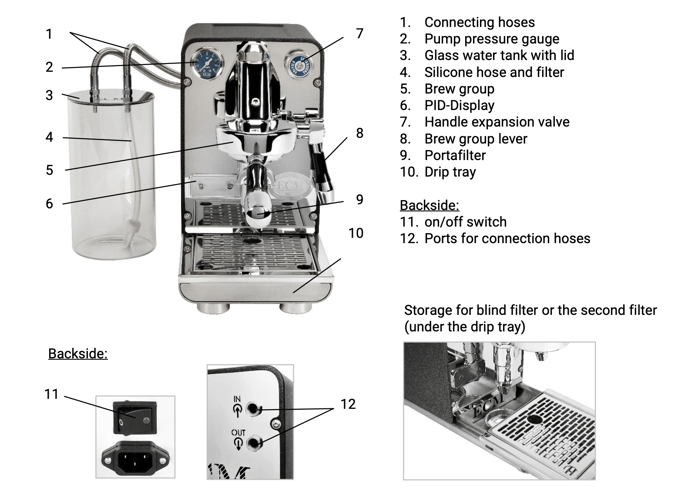ECM Puristika Espresso Machine: User Manual
In this manual, you should find everything you need to operate and maintain your ECM Puristika espresso machine.
Please read carefully before operating your single boiler, vibratory pump espresso machine. For a list of specifications, included accessories, and other details, check out the ECM Puristika product page. For setup information, please see the Setup Guide.
Getting Started:
After reading through the ECM Puristika Setup Guide, test your water. Espresso machines have specific requirements when it comes to water. There are two primary considerations: filtration and hardness. Please carefully read about the importance of water in espresso to understand how water affects your espresso machine. For further learning, check out Coffee School's Water 101.
Note: It's essential to test your water, filter, and soften to obtain 35-85 ppm to avoid scale and damage to your machine. RO (reverse osmosis) or distilled water does not contain enough mineral content and could cause issues to your machine. The SCA Water for Brewing Standards explains what's needed to obtain water that's suitable for your machine and coffee.
First Time Setup: Connecting external water reservoir
- Attach the connecting hoses to the back of the machine. Put the other end of the connecting hoses through the corresponding holes of the water tank lid. Attach the silicone hose on the inside of the water tank lid. Once connected, fill the water tank with your filtered, softened water and place the lid with the silicone hoses on the water tank. Once the machine turns on, check the connection for leaks.

First Time Setup: Connecting to Power & Filling Boilers
- Insert the power cable properly into the socket and turn the on/off switch on the back of the machine down to the “-” to turn the machine on. The orange light will illuminate indicating it's on. After a few seconds, a pump noise should occur which indicates the machine is filling the boilers. The PID will light up and display the temperature. Once it reached 93°C (which should take about 10 minutes), the machine is fully heated and ready to use.
Programming the PID:
The Puristika's PID allows users to adjust the temperature of the coffee boiler (t1), program cleaning reminders (CLN), eco mode (ECO) to automatically turn off your machine, and temperature more (o) to select between C for Celsius and F for Fahrenheit.- To enter into programming mode, press the plus and minus buttons simultaneously until t1 appears. The minus button allows you to scroll through the settings menu. The plus button selects the setting you wish to edit. Wait a moment for the PID to read the setting you have edited and then press the minus button to exit programming mode.

t1: Temperature Setting — use the +/- buttons to raise and lower brew temperature. Hotter water increases extraction and is best used on lighter roasted coffees whereas cooler temperatures reduce extraction which is best on darker roasts.
CLn: Group Cleaning Mode — with the Puristika you have the option to program a reminder for cleaning. The machine is set to 0 at the time of delivery, meaning no reminder is programmed yet. You can program in steps of 10 (0-200) by pressing + and – to prompt you to clean after the selected amount of brew cycles. For example, if you have programmed 90, you will be prompted with a “CLn” on the display to clean the brew group after 90 brew cycles.
We recommend cleaning the brew group after about 90 to 140 brew cycles. Only a brew over 15 seconds counted as a brew cycle.
ECo: Eco Mode — gives you the option to set a timer that will automatically switch off your machine in steps of 30 minutes. After the last brewing process, the machine will start the timer. The timer will be running in the background and is not visible. When the timer ends the machine will automatically turn off. To reactivate the machine, either press a PID key or switch the machine off and on again.
o: Temperature Mode — You can also set whether the boiler temperature values of “t1” should be displayed in °C or °F.
Additional Resources:
For help dialing in your equipment or pulling shots, check out the articles below or reach out to our team of coffee experts and technicians.
- Your Guide to Perfect Home Espresso
- Coffee School: Intro to Espresso
- Clive Help Center: Getting Started
- Cleaning & Maintenance
- Clive Coffee: Learn
- ECM Puristika Setup Guide
